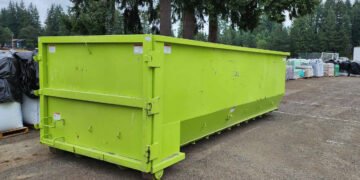Shipping containers have revolutionized trade on a global scale. And that trend shows no signs of slowing. In fact, by 2025, the shipping container industry will reach $73 billion worldwide.
But shipping containers have been gaining the attention of people who have nothing to do with trade. Tiny home enthusiasts are increasingly turning to these products as the base structure for their abodes.
But, after you buy a shipping container, what is the best way to get it from an empty box to “home-sweet-home”? The answer depends on many factors, including your time and budget.
The guide below will give you a better idea of whether you should build your own shipping container home, hire someone to do the work, or some combination of the two. Keep reading to find out which option is best for you.
Shipping Container Home Basics
Shipping containers are designed for transporting cargo across the ocean. They are made of steel, which means they are very durable and resistant to corrosion.
Most shipping containers are approximately eight feet wide and eight feet high. The standard length is either 20 feet or 40 feet, the larger of which yields about 320 square feet of living space.
There are different reasons why so many containers exist and are available for purchase. One is it is more cost-effective to sell them at their destination rather than pay for return shipping.
Shipping containers have become popular options for tiny homes because of their versatility and transportability. Although it would take some planning and money, you have the option of moving your home from one place to another.
Shipping container homes can be single- or multi-level. In fact, it is possible to stack containers up to eight-high. This had made them popular for densely populated places or for expanded vertical living space in areas where there is little land.
To build a shipping container house, you must first buy a new or used one. There are many businesses online for buying steel shipping containers.
Once you make the purchase, you have to decide if you want to build the rest on your own or hire someone to do so. Here are the pros and cons of each option.
- DIY Shipping Container Home Build
Shipping container homes require a lot of customization. This includes pouring foundations, metal cutting, welding, and plumbing.
So, doing the work yourself may make a lot of sense. But there are several things to consider before venturing out on your own.
The biggest advantage to building your own shipping container home is the cost savings. Choosing supplies and doing the work on your own is the most economical option for getting your home set up.
Another advantage is that you can design it how you want. It also can be very rewarding to live in a place of your own design and making.
And there’s nothing stopping you from changing your mind about an aspect of the design after you’ve already started the project. This is more difficult to do if you have hired someone else to plan and build your container home.
But there are some drawbacks to consider as well. Designing and building your own shipping container home takes a lot of time and patience. If there are tasks that are beyond your knowledge or expertise, you risk having a home that isn’t well insulated, wired properly, or constructed well.
This could be dangerous and even costly. If you don’t know what you are doing, you could end up spending more money down the road to get someone to correct the mistake.
- Hiring Contractors
The biggest advantage of hiring someone to build your home is convenience. They will coordinate the tasks needed to complete the project, including lining up labor and experts. Whatever welding, wiring, and specialty work needs doing, they will take care of it.
Another advantage of hiring a contractor is efficiency. Planning and completing every aspect of construction will take a great deal of your time.
That’s especially true if you are working alone or with only a partner. But contractors will have various crews lined up to complete different tasks as quickly as possible.
Unlike erecting a typical house, shipping container homes can be built in a matter of months. This will go even faster if you have a team, or several teams, tackling different aspects of the build.
Of course, you should plan to pay more for those conveniences. You will need to spend time shopping around for contractors to do the job. And you will want to make sure that each is qualified.
- Hybrid Plan
A third option is a combination of doing the planning and some construction work yourself while contracting out the rest. This option allows you to design your shipping container home how you want and keep costs down. Do as much work as you are comfortable with and subcontract out projects that are beyond the scope of your expertise.
- Prefabrication
There are plenty of companies that deliver and assemble shipping container homes that are move-in ready. The main reason to consider this option is if you do not have the skills to carry out the necessary design and implementation aspects of a DIY plan.
Also, buying a prefabricated home is the quickest option available. Most companies that sell these products have many models in stock and ready to ship to you.
Another advantage is that companies that sell prefabricated container homes are experts on the topic. They can give you advice on many different aspects of living in a shipping container. This might pertain to zoning laws or details about getting your tiny home set up.
Prefabricated homes also offer convenience. There is no planning, shopping around for supplies, or interviewing contractors. The only extra work that needed is laying a foundation and connecting utilities.
The flip side of this is limited customization. You may find that some places give a lot of leeway in choosing various details of your home. But this will depend on the business.
Another downside is that buying a prefabricated home will be the most expensive option. Since you are paying a company to coordinate and carry out all aspects of the construction, it will cost you a premium. But the extra money may more than offset the many other advantages listed above.
Plan Your Tiny Home Today
Now that you have an idea of the different options available for constructing your shipping container tiny home, you can decide which option is best for you. Be sure to thoroughly research all options available where you live, including delivery costs. The most important thing you can do in planning your shipping container home is knowing what to expect from the outset.
We hope this information was helpful to you. Be sure to check out some of our other posts on technology, fashion, celebrity news, and many other topics.
Read Also : An Introduction to Shariah-Compliance Business Account






























































